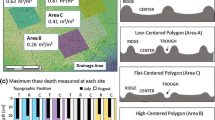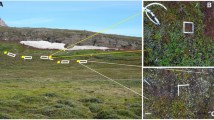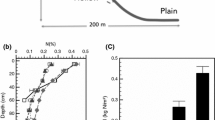Abstract
Formation of thermokarst features, ground subsidence caused by thaw of ice-rich permafrost, can result in increased export of inorganic nitrogen (N) from arctic tundra to downstream ecosystems. We compared physical characteristics, N pools, and rates of N transformations in soils collected from thermo-erosion gullies, intact water tracks (the typical precursor landform to thermo-erosion gullies), and undisturbed tundra to test potential mechanisms contributing to export of inorganic N. Subsidence exposes mineral soils, which tend to contain higher abundance of inorganic ions relative to surface soils, and may bring inorganic N into contact with flowing water. Alternatively, physical mixing may increase aeration and drainage of soils, which could promote N mineralization and nitrification while suppressing denitrification. Finally, some soil types are more prone to formation of thermokarst, and if these soils are relatively N-rich, thermokarst features may export more N than surrounding tundra. Inorganic N pools in thermo-erosion gullies were similar to the mean for all tundra types in this region, as well as to water tracks when integrated across two sampled depths. Thus, soils prone to thermo-erosion are not intrinsically N-rich, and increased N availability in thermokarst features is apparent only at sub-regional spatial scales. However, vertical profiles of N pools and transformation rates were homogenized within thermo-erosion gullies compared to adjacent intact tundra, indicating that physical mixing brings inorganic N to the surface, where it may be subject to hydrologic export. Increased inorganic N availability caused by formation of thermo-erosion gullies may have acute, localized consequences for aquatic ecosystems downstream of positions within drainage networks that are susceptible to thermo-erosion.






Similar content being viewed by others
References
ARC-LTER Arctic Long-Term Ecological Research Program, Gus Shaver, Soil chemistry, ecosystems. http://mbl.edu/arc/datacatalog.html. Accessed 2011
Bockheim JG (2007) Importance of cryoturbation in redistributing organic carbon in permafrost-affected soils. Soil Sci Soc Am J 71:1335–1342
Bockheim J, Hinkel K (2012) Accumulation of excess ground ice in an age sequence of drained thermokarst lake basins, arctic Alaska. Permafrost Periglac Process 23:231–236
Booth M, Stark J, Hart S (2006) Soil mixing effects on inorganic nitrogen production and consumption in forest and shrubland soils. Plant Soil 289:5–15
Bowden WB, Gooseff MN, Balser A, Green A, Peterson BJ, Bradford J (2008) Sediment and nutrient delivery from thermokarst features in the foothills of the North Slope, Alaska: potential impacts on headwater stream ecosystems. J Geophys Res-Biogeosci 113:G02026
Brzostek ER, Blair JM, Dukes JS, Frey SD, Hobbie SE, Melillo JM, Mitchell RJ, Pendall E, Reich PB, Shaver GR, Stefanski A, Tjoelker MG, Finzi AC (2012) The effect of experimental warming and precipitation change on proteolytic enzyme activity: positive feedbacks to nitrogen availability are not universal. Glob Change Biol 18:2617–2625
Buckeridge KM, Grogan P (2010) Deepened snow increases late thaw biogeochemical pulses in mesic low arctic tundra. Biogeochemistry 101:105–121
Buckeridge KM, Cen YP, Layzell DB, Grogan P (2010) Soil biogeochemistry during the early spring in low arctic mesic tundra and the impacts of deepened snow and enhanced nitrogen availability. Biogeochemistry 99:127–141
Chapin FS, Fetcher N, Kielland K, Everett KR, Linkins AE (1988) Productivity and nutrient cycling of Alaskan tundra: enhancement by flowing soil water. Ecology 69:693–702
Cheng W, Virginia RA, Oberbauer SF, Gillespie CT, Reynolds JF (1998) Soil nitrogen, microbial biomass, and respiration along an arctic toposequence. Soil Sci Soc Am J 62:654–662
DeMarco J, Mack MC, Bret-Harte MS (2011) The effects of snow, soil microenvironment, and soil organic matter quality on N availability in three Alaskan arctic plant communities. Ecosystems 14:804–817
Fortier D, Allard M, Shur Y (2007) Observation of rapid drainage system development by thermal erosion of ice wedges on Bylot Island, Canadian Arctic Archipelago. Permafrost Periglac Process 18:229–243
Frey K, McClelland J, Holmes R, Smith L (2007) Impacts of climate warming and permafrost thaw on the riverine transport of nitrogen and phosphorus to the Kara Sea. J Geophys Res-Biogeosci 112:G04S58
Giblin AE, Nadelhoffer KJ, Shaver GR, Laundre JA, McKerrow AJ (1991) Biogeochemical diversity along a riverside toposequence in arctic Alaska. Ecol Monogr 61:415–435
Godin E, Fortier D (2012) Geomorphology of a thermo-erosion gully, Bylot Island, Nunavut, Canada. Can J Earth Sci 49:979–986
Hamilton TD (2003a) Glacial geology of Toolik Lake and the Upper Kuparuk River region. In: Walker DA (ed) Biological papers of the University of Alaska. University of Alaska, Fairbanks
Hamilton TD (2003b) Surficial geology of the Dalton Highway (Itkillik-Sagavanirktok rivers) area, southern Arctic foothills. Alaska Division of Geological & Geophysical Surveys, Alaska
Hinzman LD, Kane DL, Gieck RE, Everett KR (1991) Hydrologic and thermal-properties of the active layer in the Alaskan Arctic. Cold Reg Sci Technol 19:95–110
Hobbie SE, Gough L (2002) Foliar and soil nutrients in tundra on glacial landscapes of contrasting ages in northern Alaska. Oecologia 131:453–462
Hobbie SE, Miley TA, Weiss MS (2002) Carbon and nitrogen cycling in soils from acidic and nonacidic tundra with different glacial histories in Northern Alaska. Ecosystems 5:761–774
Jonasson S, Shaver GR (1999) Within-stand nutrient cycling in arctic and boreal wetlands. Ecology 80:2139–2150
Jorgenson MT, Osterkamp TE (2005) Response of boreal ecosystems to varying modes of permafrost degradation. Can J For Res 35:2100–2111
Jorgenson MT, Shur Y, Osterkamp T (2009) Thermokarst in Alaska. In: Ninth international conference on permafrost. University of Alaska Fairbanks, pp 117–124
Kaiser C, Meyer H, Rusalimova O, Barsukov P, Richter A (2007) Conservation of soil organic matter through cryoturbation in arctic soils in Siberia. J Geophys Res-Biogeosci 112(G2):G02017
Karlstrom TNV (1964) Surficial geology of Alaska: U.S. Geological Survey Miscellaneous Geologic Investigations Map 357, 2 sheets, scale 1:1,584,000
Keuper F, van Bodegom PM, Dorrepaal E, Weedon JT, van Hal J, van Logtestijn RSP, Aerts R (2012) A frozen feast: thawing permafrost increases plant-available nitrogen in subarctic peatlands. Glob Change Biol 18:1998–2007
Kokelj SV, Burn C (2005) Geochemistry of the active layer and near-surface permafrost, Mackenzie Delta region, Northwest Territories, Canada. Can J Earth Sci 42:37–48
Lantz TC, Kokelj SV (2008) Increasing rates of retrogressive thaw slump activity in the Mackenzie Delta region, NWT. Can Geophys Res Lett 35:L06502
Lantz TC, Kokelj SV, Gergel SE, Henryz GHR (2009) Relative impacts of disturbance and temperature: persistent changes in microenvironment and vegetation in retrogressive thaw slumps. Glob Change Biol 15:1664–1675
Lavoie M, Mack MC, Schuur EAG (2011) Effects of elevated nitrogen and temperature on carbon and nitrogen dynamics in Alaskan arctic and boreal soils. J Geophys Res-Biogeosci 116:G03013
Lee H, Schuur EAG, Vogel JG (2010) Soil CO2 production in upland tundra where permafrost is thawing. J Geophys Res-Biogeosci 115:G01009
Mack MC, Schuur EAG, Bret-Harte MS, Shaver GR, Chapin FS (2004) Ecosystem carbon storage in arctic tundra reduced by long-term nutrient fertilization. Nature 431:440–443
McClelland J, Stieglitz M, Pan F, Holmes R, Peterson B (2007) Recent changes in nitrate and dissolved organic carbon export from the upper Kuparuk River, North Slope, Alaska. J Geophys Res-Biogeosci 112:G04S60
Nadelhoffer KJ, Giblin AE, Shaver GR, Laundre JA (1991) Effects of temperature and substrate quality on element mineralization in 6 arctic soils. Ecology 72:242–253
Natali SM, Schuur EAG, Trucco C, Hicks Pries CE, Crummer KG, Baron Lopez AF (2011) Effects of experimental warming of air, soil and permafrost on carbon balance in Alaskan tundra. Glob Change Biol 17:1394–1407
Neff JC, Hooper DU (2002) Vegetation and climate controls on potential CO2, DOC and DON production in northern latitude soils. Glob Change Biol 8:872–884
Osterkamp TE, Jorgenson MT, Schuur EAG, Shur YL, Kanevskiy MZ, Vogel JG, Tumskoy VE (2009) Physical and ecological changes associated with warming permafrost and thermokarst in interior Alaska. Permafrost Periglac Process 20:235–256
Ping CL, Bockheim JG, Kimble JM, Michaelson GJ, Walker DA (1998) Characteristics of cryogenic soils along a latitudinal transect in Arctic Alaska. J Geophys Res-Atmospheres 103:28917–28928
Robertson GP, Coleman D, Bledsoe C, Sollins P (1999) Standard Soil Methods for Long-Term Ecological Research. Oxford University Press, New York
Schimel JP, Chapin FS (1996) Tundra plant uptake of amino acid and NH4 + nitrogen in situ: plants compete well for amino acid N. Ecology 77:2142–2147
Schimel JP, Bilbrough C, Welker JA (2004) Increased snow depth affects microbial activity and nitrogen mineralization in two Arctic tundra communities. Soil Biol Biochem 36:217–227
Schuur EAG, Crummer KG, Vogel JG, Mack MC (2007) Plant species composition and productivity following permafrost thaw and thermokarst in alaskan tundra. Ecosystems 10:280–292
Shaver GR, Johnson LC, Cades DH, Murray G, Laundre JA, Rastetter EB, Nadelhoffer KJ, Giblin AE (1998) Biomass and CO2 flux in wet sedge tundras: responses to nutrients, temperature, and light. Ecol Monogr 68:75–97
Team Toolik Environmental Data Center (2011) Meteorological monitoring program at Toolik. Toolik Field Station, Institute of Arctic Biology, University of Alaska Fairbanks, Fairbanks 99775
USGS/NPS (1999) State surficial geology map of Alaska. National Park Service Alaska Regional Office, Anchorage
Walker DA (2008) Toolik-Arctic Geobotanical Atlas. Alaska Geobotany Center, www.geobotany.uaf.edu
Walker DA, Barry NC (1991) Toolik Lake permanent plots: site factors, soil physical and chemical properties, plant species cover, photographs, and soil descriptions. In: Department of Energy R4D Program data report, Joint Facility for Regional Ecosystem Analysis, Institute of Arctic and Alpine Research, National Snow and Ice Data Center, Boulder, CO
Walker DA, Everett KR (1991) Loess ecosystems of Northern Alaska: regional gradient and toposequence at Prudhoe Bay. Ecol Monogr 61:437–464
Walker D, Raynolds M, Maier H, Barbour E, Neufeld G (2010) Circumpolar geobotanical mapping: a web-based plant-to-planet approach for vegetation-change analysis in the arctc. Viten 1:125–128
Whittinghill KA, Hobbie SE (2011) Effects of landscape age on soil organic matter processing in Northern Alaska. Soil Sci Soc Am J 75:907–917
Yano Y, Shaver GR, Giblin AE, Rastetter EB, Nadelhoffer KJ (2010) Nitrogen dynamics in a small arctic watershed: retention and downhill movement of 15N. Ecol Monogr 80:331–351
Yoshinari T, Hynes R, Knowles R (1977) Acetylene inhibition of nitrous-oxide reduction and measurement of denitrification and nitrogen-fixation in soil. Soil Biol Biochem 9:177–183
Zhang T, Barry R, Knowles J, Heginbottom J, Brown J (1999) Statistics and characteristics of permafrost and ground ice distribution in the Northern Hemisphere. Polar Geogr 23:132–154
Acknowledgments
We thank Andrew Balser for assistance with site selection and interpretation of map records, and Randy Fulweber and Jason Stuckey for providing the site map. We gratefully acknowledge Margit Jaeger and Ann Olsson for assistance in the laboratory. We thank two anonymous reviewers for comments that improved the manuscript. This work was supported by the National Science Foundation ARCSS program (OPP-0806465), and an NSF post-doctoral fellowship to TKH (OPP-0817056).
Author information
Authors and Affiliations
Corresponding author
Additional information
Responsible Editor: Sujay Kaushal
Rights and permissions
About this article
Cite this article
Harms, T.K., Abbott, B.W. & Jones, J.B. Thermo-erosion gullies increase nitrogen available for hydrologic export. Biogeochemistry 117, 299–311 (2014). https://doi.org/10.1007/s10533-013-9862-0
Received:
Accepted:
Published:
Issue Date:
DOI: https://doi.org/10.1007/s10533-013-9862-0




